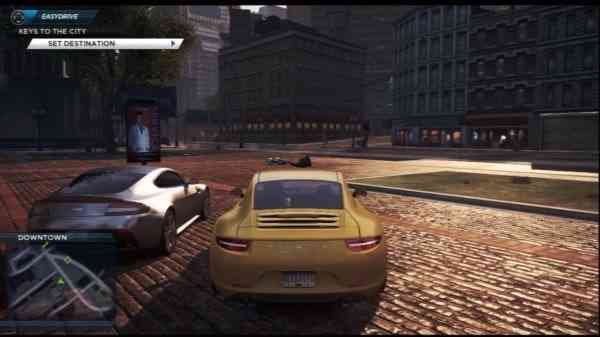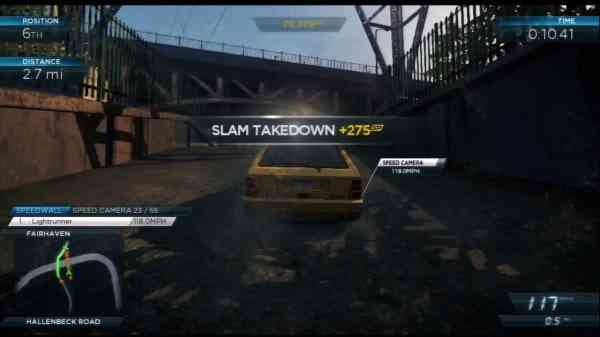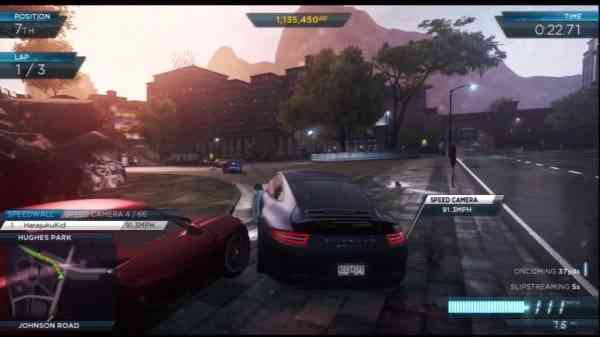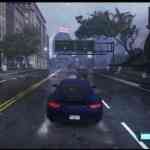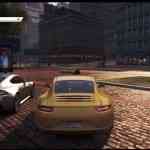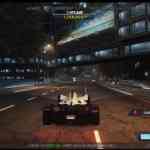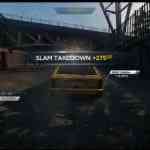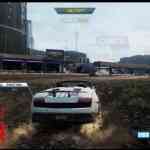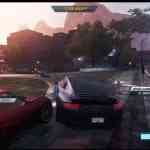The Need For Speed (NFS) series has certainly seen its ups and downs over the past several years. From year to year we have seen attempts to take the series in bold new directions. While occasionally this has worked more often than not the series has seemed to fall flat on its face to the point where NFS almost lacks a true identity anymore. While the latest release, Need for Speed: Most Wanted, shares the same name as one of the Xbox 360’s best launch titles, it certainly is not a reboot, remake or reimagining from the team at Criterion Games. After some extended playtime I can honestly say that if you are a fan of arcade racing, the NFS series, or even Burnout, you are probably going to really like what you see.
If we caught a glimpse of what Criterion had in mind for the NFS series two years ago with Hot Pursuit, Most Wanted appears to be the full realization of their vision for the series. Like Hot Pursuit, Most Wanted combines elements of both the NFS and Burnout series into one game. While Most Wanted lacks that over-the-top sense of speed that Burnout is known for, gameplay elements such as a heavy focus on drifting, takedowns and boost gained by driving dangerously all carry over to Most Wanted.
Instead of a corny story supported by cheesy full motion video cut scenes, which I loved by the way, Most Wanted revolves around earning Speed Points (SP) both in single player and online. In solo play, as you earn SP you unlock the ability to race against exotic cars that are on a “Most Wanted” list. Winning these races doesn’t immediately unlock that car for use as winning only earns you the right to try and perform a Takedown on it to earn it. As you make your way up the Most Wanted list cars become even more exotic.
Criterion has taken a somewhat unconventional but refreshing approach to car selection and modification. Instead of unlocking cars through gameplay they are located all around the city of Fairhaven. Drivable cars are indicated by their manufacturer’s logo above them on screen. If you find it you can drive it and once you find each car they are immediately accessible via the in-game EasyDrive menu system (more on this later). Each car has its own set of races which is known as a SpeedList. Modifications are unlocked in progression by placing first or second in the various events in that car’s SpeedList. While some events are the same for different cars not every SpeedList is identical. The first time you do any event you must follow your GPS and locate it. Any time you do that race again, you can immediately jump to the start and skip over having to drive to each and every event. You can drive if you want too though but this “fast travel” is a welcome option.
Finding a favorite car and sticking with it has its rewards. Stick with a car long enough and Pro modifications open up. These mods generally overcome any drawbacks previous mods had. For example, Pro off road tires have excellent traction on both off road and regular road surfaces. The problem with this system is that you have to play through every single car’s SpeedList if you want to get its available Pro upgrades. It’s a whole other thing to play each car to the point where Pro mods become available. I guess one could argue that it adds legs to the title but at a certain point I think it becomes tedious.
Race events are divided a bit more simply than previous NFS games and are categorized into four types. There are circuit races, point to point races, police pursuits and speed runs where your average speed over the course of the race counts. Race events are also defined by difficulty. Being that Most Wanted is an arcade racer there is a crazy amount of rubberband AI present. In fact I would have a hard time naming another game where it is more obvious. The great thing is that this rubberbanding works as much for you as it can against you. Everyone has had a race to two stolen from them at one time or another from cheap AI. Seldom is the favor returned, but in Most Wanted it is. Crashing does not leave you entirely out of the race. As long as you are not too close to the finish you still have a chance to challenge for top three. So here I don’t mind the rubberband effect as much as I have in other racing games. Add to this that EA still has not fixed the fact that you have to endure a load screen to restart a race and you won’t mind the chance to “catch-up” in a race and not have to restart it.
Autolog “2.0” is back and remains as much of a tantalizing diversion as it ever has. Speed Points add a new dimension to what you can compete against your friends for. Most Wanted also features an in-game menu system called EasyDrive that is completely mapped to the d-pad. The idea here is that you never have to leave the actual gameplay to access a menu system as it is neatly tucked up in the upper left corner of the screen. Hitting the d-pad opens it up and you can select races, customize your car, check Autolog challenges, and much more all without having to pause the game. It is pretty slick but not all that different from how the menu worked in Burnout Paradise multiplayer. The big problem I found with the EasyDrive menu was trying to navigate it while still driving my car. It is hard enough to do that let alone do it when you are in the middle of a police pursuit. I’d rather just hit Start or Select button and have the game pause.
Speaking of police chases they are back in a big way. I mentioned earlier that I felt the NFS series has struggled to find its identity in recent versions such as The Run, Undercover, and the horrible Shift series. I associate NFS with cop chases and I’m happy to see them and the heat system back in play. The higher your heat level the more resources the police throw at you in an effort to stop you. Once you have evaded the cops you must stay out of sight for a specified cool down period. If you are spotted during this time the chase is back on. This is every bit as fun as I remember it being in the original Most Wanted.
Online Criterion has made a bold move and done away with lobbies and menus when setting up races. While this may sound great in theory, it does have its limitations. Instead of a traditional lobby players in a multiplayer session all must race to a Meet Up. The first person to the Meet Up gains some extra SP. It’s almost like a race before the actual race. On the way there Takedowns count. Once everyone is at a Meet Up gameplay options are served up in SpeedLists made up of 5 races and these can be further customized. Thankfully there is a timer for getting to Meet Ups. If the timer runs out, the race just starts and relocates the players not yet at the Meet Up. With the right people, this approach to online multiplayer with no lobbies is relatively simple, unique and fun; however, in public games where you do not have control over the quality of people you play with, things can sometimes devolve into a demolition derby. Like most games, playing with friends enhances the online multiplayer experience tremendously. Overall I like what Criterion has done here. There is plenty of variety in event types including team-based ones. Multiplayer also has its own set of levels determined by the SP that you earn. The SP you earn in single player counts towards your level in multiplayer and vice-versa.
While the cars in Most Wanted might not sport the visual acuity of what you might see in Forza, they still manage to look great and are detailed right down to the driver and his animations such as steering, shifting and even bracing himself with one arm when in reverse. The real stars of the game however are the environments and effects. You will drive through various cities, industrial areas, highways, countrysides and mountain locales. Each is richly detailed and populated with traffic and roadside items that can be crashed into. This high amount of detail can work against you though. Without the map in the corner of the screen it can be hard to tell which way the road turns at times. As typical in any NFS game I have ever played the framerate aims for 30 fps. It is consistent for the most part but there are several instances of framerate stutter and minor slowdown. These hiccups didn’t kill the experience, at least it didn’t for me, but Burnout Paradise’s blistering framerate proved that Criterion can do better. I would happily take a little less environmental detail and effects for a superior framerate any day.
You know those warnings about photosensitive seizures in game manuals? They apply here. Whether it is a speed camera, impact with other cars or objects, or engaging your car’s boost, I don’t know of any other game that uses so many flash effects. Every race and Most Wanted car has its own introductory cut scene too, some of which seem inspired by an acid trip. I give Criterion and EA credit though as it certainly brings a unique sense of style to the game.
I don’t typically like music playing when I am playing a racing game but in Most Wanted’s case I left the tunes on. They are catchy and provide a nice background beat to the action provided you turn them down from their default settings. It is good driving music. Engine notes do a decent enough job sounding like their real life counterparts but what stands out most are the ambient and environmental effects. Race through a tunnel and the echo of your engine is deafening but oh so sweet. Crashes sound substantial and there is excellent use of surround sound. Overall I found the sound to be pretty good.
Criterion has been clear from the get-go that they were looking to create a racing experience that focused on freedom and social aspects and they have done just that. Although far from being technically perfect, Need For Speed: Most Wanted is a solid arcade racing experience. Whether solo or within its unique approach to multiplayer there is more than enough here to keep players entertained for a long time. Now that we have an open world and cop chases again will someone please give us a Hunter mode?
